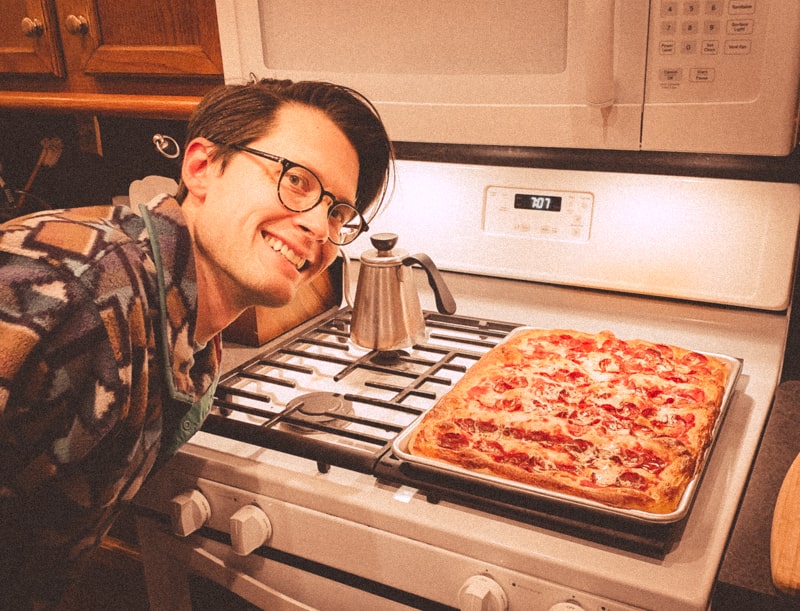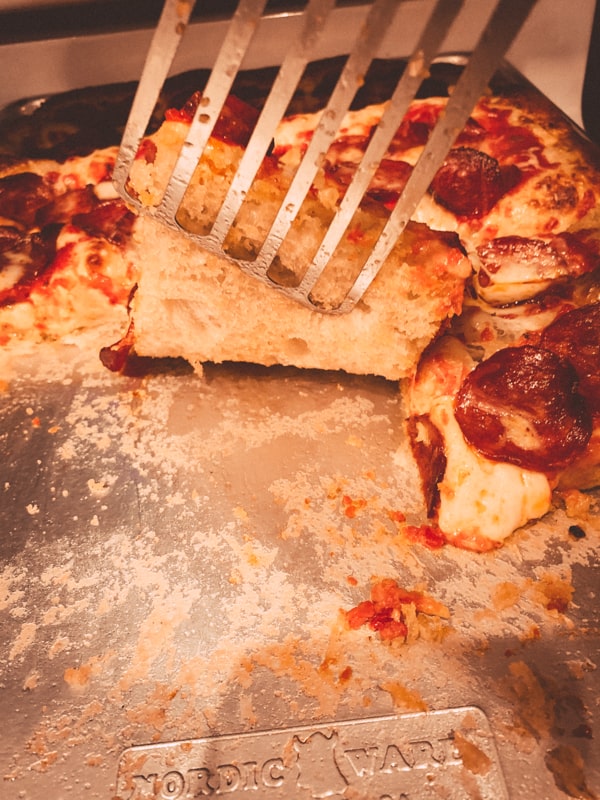Ratings, percentages, and more
rating: 3/8 slices

hydration: 80%

difficulty: challenging

Ingredient percents
| Ingredient | Standard % | Baker’s % |
| Flour (567g) | 53.29% | 100% |
| Salt (11g) | 1.03% | 1.95% |
| Yeast (4g) | 0.38% | 0.70% |
| Water (454g) | 42.67% | 80% |
| Olive Oil (28g) | 2.63% | 5% |
Summary
- Not sure what went wrong but this one didn’t come out well.
- Crust did not brown.
- May have overtopped.
Here’s the book I pulled this recipe from
A Large, Rectangular Disappointment

I made this on November 13th, 2021. Not sure if I’ll make it again as it didn’t turn out well. Fortunetely as Mr. Reinhart says, “pizza is such a perfect food that, unless you burn it, it is nearly impossible to screw it up.” So despite it’s shortcomings, it was still decent.
What went wrong? The crust wouldn’t brown. I cooked it 18 minutes — in the range the recipe suggests. When it clearly was not done, I baked it four more minutes, than 3 more after that. (I put foil on top so that it didn’t burn the toppings too much.) But even after all that extra time, it was still a pale color and the toppings couldn’t handle much more so I pulled it. Because it didn’t brown, it stuck to my brand new unseasoned pan. (Reinhart says you can put down a pan liner but don’t have to, so I didn’t.) It also didn’t crisp at all. Thankfully, it did cook through.

In these moments, I’m reminded that this is when you really learn. When something doesn’t go right. As write, I’m still running through the list of potential issues. Too much cheese on top? Maybe. It says thin sliced but mine (ordered and delivered so I didn’t have control), was not thinly sliced. So, in order to cover the entire pizza, I used 10 ounces of cheese. I also topped it with 5 ounces of pepperoni and didn’t carefully measure the sauce to match the recipe, although I think I was close. So, I guess, my best guess is that I went overboard on the toppings.
Or it could be that this book is expecting too much from one dough recipe. The dough works great for Detroit style pizza but not for the other styles it’s used for in the book. Maybe a different recipe is needed entirely, and maybe that’s the reason that Reinhart has only one “grandma” style recipe in this book but multiples of every other style covered.
That said, if I make this again, in addition to reducing the toppings, I’ll also reduce the dough from the 907 grams Reinhart suggests. (I actually used 900 grams this time.) I might also cook at a lower temp. This time I went at 455 — I usually add 5 degrees because my poorly insulated oven seems to run a little cool. Finally, I won’t push the dough quite to the edge of the pan because, while it stuck to the bottom, it completely adhered to the sides.
So, I can’t recommend this recipe at the moment. But, to be fair, I strayed from the recipe in my toppings. I’m also encouraged that the intro to the recipe admits it’s a hard pizza to make, saying that it’s especially hard because the toppings tend to cook before the crust browns — exactly what I experienced.
Cold
Surprisingly, I liked this pizza better cold. Probably because I wasn’t expecting any sort of crunch or crispiness in the crust. Since there wasn’t any, it lived up to my expectations. A nice, soft doughy slice of cold pizza.
Day Two
What a difference a day makes, or two in my case. On day three, I reheated two slices with added olive oil in the bottom of one and one without. The one without was ready in 15 minutes at 425. The oil added one took 19 minutes and the crust might have been able to handle even more. Anyway, the oil-less version had nice crispy bits and great flavor. The oil-added version had some sublime crunchy areas, bursting with oily goodness. The reheat made me see why people like this style and the potential it has. It gave me a reason to try again, or at least consider trying again.
Final Thought
A pale crust decreased my Reinhart trust. As I am sure most grandmas would, I considered this a bust.
